Refine search
No keyword found to refine search
keywords EN
Places
Names
143 documents found
| 1 | 3 |
Documents per page :

Trip to the Thar desert, Rajasthan India
Sandrine Huet / Le Pictorium
LePictorium_0146093.jpg
The Thar desert spreads on 200 000km2 around Jaisalmer. The old nomadic tribes are for most of them now settled. The Bhils belong to the untouchable cast and try to maintain their way of life by redeveloping their arts and crafts and traditional music and dances.
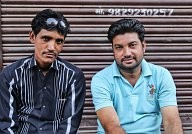
Rajasthan
Sandrine Huet / Le Pictorium
LePictorium_0146577.jpg
Pictures of Rajasthan, portraits and lifestyles
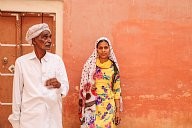
Portraits of women and children of Rajasthan. In the countryside, the women of Rajasthan wear long skirts, a small bolero and veil with bright colors. They adorn themselves with silver jewels ( earrings, nose rings, necklaces, arm and ankle bracelets). They raise the children and participate in the rural works ( cattle, farming, wood and water tasks). Most of the marriages are settled and the place of women is by and at the service of their in-laws.
Sandrine Huet / Le Pictorium
LePictorium_0146578.jpg
Pictures of Rajasthan, portraits and lifestyles
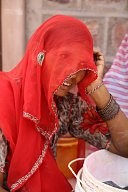
Portraits of women and children of Rajasthan. In the countryside, the women of Rajasthan wear long skirts, a small bolero and veil with bright colors. They adorn themselves with silver jewels ( earrings, nose rings, necklaces, arm and ankle bracelets). They raise the children and participate in the rural works ( cattle, farming, wood and water tasks). Most of the marriages are settled and the place of women is by and at the service of their in-laws.
Sandrine Huet / Le Pictorium
LePictorium_0146579.jpg
Pictures of Rajasthan, portraits and lifestyles

Portraits of women and children of Rajasthan. In the countryside, the women of Rajasthan wear long skirts, a small bolero and veil with bright colors. They adorn themselves with silver jewels ( earrings, nose rings, necklaces, arm and ankle bracelets). They raise the children and participate in the rural works ( cattle, farming, wood and water tasks). Most of the marriages are settled and the place of women is by and at the service of their in-laws.
Sandrine Huet / Le Pictorium
LePictorium_0146580.jpg
Pictures of Rajasthan, portraits and lifestyles
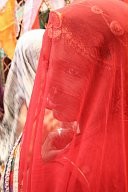
Portraits of women and children of Rajasthan. In the countryside, the women of Rajasthan wear long skirts, a small bolero and veil with bright colors. They adorn themselves with silver jewels ( earrings, nose rings, necklaces, arm and ankle bracelets). They raise the children and participate in the rural works ( cattle, farming, wood and water tasks). Most of the marriages are settled and the place of women is by and at the service of their in-laws.
Sandrine Huet / Le Pictorium
LePictorium_0146581.jpg
Pictures of Rajasthan, portraits and lifestyles
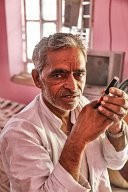
Portraits of men in Rajasthan
Sandrine Huet / Le Pictorium
LePictorium_0146582.jpg
Men of Rajasthan are very often breeders, ex nomads called Raikas.
they wear a 9 meter-long turban that is the main piece of their traditional costume. It has multi purposes and informs on the man's social status. Men in Rajasthan often have a mustache as a symbol of their virility.
they wear a 9 meter-long turban that is the main piece of their traditional costume. It has multi purposes and informs on the man's social status. Men in Rajasthan often have a mustache as a symbol of their virility.
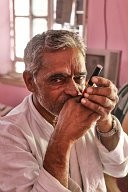
Portraits of men in Rajasthan
Sandrine Huet / Le Pictorium
LePictorium_0146583.jpg
Men of Rajasthan are very often breeders, ex nomads called Raikas.
they wear a 9 meter-long turban that is the main piece of their traditional costume. It has multi purposes and informs on the man's social status. Men in Rajasthan often have a mustache as a symbol of their virility.
they wear a 9 meter-long turban that is the main piece of their traditional costume. It has multi purposes and informs on the man's social status. Men in Rajasthan often have a mustache as a symbol of their virility.

Portraits of men in Rajasthan
Sandrine Huet / Le Pictorium
LePictorium_0146584.jpg
Men of Rajasthan are very often breeders, ex nomads called Raikas.
they wear a 9 meter-long turban that is the main piece of their traditional costume. It has multi purposes and informs on the man's social status. Men in Rajasthan often have a mustache as a symbol of their virility.
they wear a 9 meter-long turban that is the main piece of their traditional costume. It has multi purposes and informs on the man's social status. Men in Rajasthan often have a mustache as a symbol of their virility.
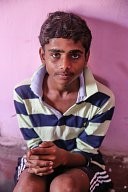
Portraits of men in Rajasthan
Sandrine Huet / Le Pictorium
LePictorium_0146585.jpg
Men of Rajasthan are very often breeders, ex nomads called Raikas.
they wear a 9 meter-long turban that is the main piece of their traditional costume. It has multi purposes and informs on the man's social status. Men in Rajasthan often have a mustache as a symbol of their virility.
they wear a 9 meter-long turban that is the main piece of their traditional costume. It has multi purposes and informs on the man's social status. Men in Rajasthan often have a mustache as a symbol of their virility.
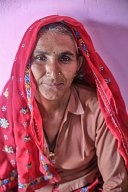
Portraits of women and children of Rajasthan. In the countryside, the women of Rajasthan wear long skirts, a small bolero and veil with bright colors. They adorn themselves with silver jewels ( earrings, nose rings, necklaces, arm and ankle bracelets). They raise the children and participate in the rural works ( cattle, farming, wood and water tasks). Most of the marriages are settled and the place of women is by and at the service of their in-laws.
Sandrine Huet / Le Pictorium
LePictorium_0146586.jpg
Pictures of Rajasthan, portraits and lifestyles
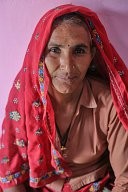
Portraits of women and children of Rajasthan. In the countryside, the women of Rajasthan wear long skirts, a small bolero and veil with bright colors. They adorn themselves with silver jewels ( earrings, nose rings, necklaces, arm and ankle bracelets). They raise the children and participate in the rural works ( cattle, farming, wood and water tasks). Most of the marriages are settled and the place of women is by and at the service of their in-laws.
Sandrine Huet / Le Pictorium
LePictorium_0146587.jpg
Pictures of Rajasthan, portraits and lifestyles
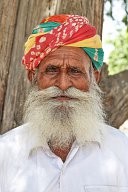
Portraits of men in Rajasthan
Sandrine Huet / Le Pictorium
LePictorium_0146588.jpg
Men of Rajasthan are very often breeders, ex nomads called Raikas.
they wear a 9 meter-long turban that is the main piece of their traditional costume. It has multi purposes and informs on the man's social status. Men in Rajasthan often have a mustache as a symbol of their virility.
they wear a 9 meter-long turban that is the main piece of their traditional costume. It has multi purposes and informs on the man's social status. Men in Rajasthan often have a mustache as a symbol of their virility.
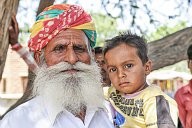
Portraits of men in Rajasthan
Sandrine Huet / Le Pictorium
LePictorium_0146589.jpg
Men of Rajasthan are very often breeders, ex nomads called Raikas.
they wear a 9 meter-long turban that is the main piece of their traditional costume. It has multi purposes and informs on the man's social status. Men in Rajasthan often have a mustache as a symbol of their virility.
they wear a 9 meter-long turban that is the main piece of their traditional costume. It has multi purposes and informs on the man's social status. Men in Rajasthan often have a mustache as a symbol of their virility.
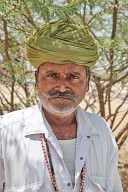
Portraits of men in Rajasthan
Sandrine Huet / Le Pictorium
LePictorium_0146590.jpg
Men of Rajasthan are very often breeders, ex nomads called Raikas.
they wear a 9 meter-long turban that is the main piece of their traditional costume. It has multi purposes and informs on the man's social status. Men in Rajasthan often have a mustache as a symbol of their virility.
they wear a 9 meter-long turban that is the main piece of their traditional costume. It has multi purposes and informs on the man's social status. Men in Rajasthan often have a mustache as a symbol of their virility.
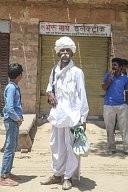
Portraits of men in Rajasthan
Sandrine Huet / Le Pictorium
LePictorium_0146591.jpg
Men of Rajasthan are very often breeders, ex nomads called Raikas.
they wear a 9 meter-long turban that is the main piece of their traditional costume. It has multi purposes and informs on the man's social status. Men in Rajasthan often have a mustache as a symbol of their virility.
they wear a 9 meter-long turban that is the main piece of their traditional costume. It has multi purposes and informs on the man's social status. Men in Rajasthan often have a mustache as a symbol of their virility.
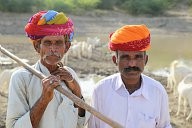
Portraits of men in Rajasthan
Sandrine Huet / Le Pictorium
LePictorium_0146592.jpg
Men of Rajasthan are very often breeders, ex nomads called Raikas.
they wear a 9 meter-long turban that is the main piece of their traditional costume. It has multi purposes and informs on the man's social status. Men in Rajasthan often have a mustache as a symbol of their virility.
they wear a 9 meter-long turban that is the main piece of their traditional costume. It has multi purposes and informs on the man's social status. Men in Rajasthan often have a mustache as a symbol of their virility.
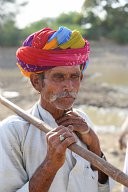
Portraits of men in Rajasthan
Sandrine Huet / Le Pictorium
LePictorium_0146593.jpg
Men of Rajasthan are very often breeders, ex nomads called Raikas.
they wear a 9 meter-long turban that is the main piece of their traditional costume. It has multi purposes and informs on the man's social status. Men in Rajasthan often have a mustache as a symbol of their virility.
they wear a 9 meter-long turban that is the main piece of their traditional costume. It has multi purposes and informs on the man's social status. Men in Rajasthan often have a mustache as a symbol of their virility.
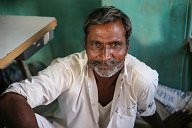
Portraits of men in Rajasthan
Sandrine Huet / Le Pictorium
LePictorium_0146594.jpg
Men of Rajasthan are very often breeders, ex nomads called Raikas.
they wear a 9 meter-long turban that is the main piece of their traditional costume. It has multi purposes and informs on the man's social status. Men in Rajasthan often have a mustache as a symbol of their virility.
they wear a 9 meter-long turban that is the main piece of their traditional costume. It has multi purposes and informs on the man's social status. Men in Rajasthan often have a mustache as a symbol of their virility.
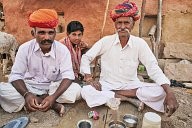
Portraits of men in Rajasthan
Sandrine Huet / Le Pictorium
LePictorium_0146595.jpg
Men of Rajasthan are very often breeders, ex nomads called Raikas.
they wear a 9 meter-long turban that is the main piece of their traditional costume. It has multi purposes and informs on the man's social status. Men in Rajasthan often have a mustache as a symbol of their virility.
they wear a 9 meter-long turban that is the main piece of their traditional costume. It has multi purposes and informs on the man's social status. Men in Rajasthan often have a mustache as a symbol of their virility.
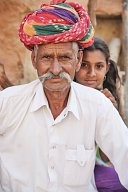
Portraits of men in Rajasthan
Sandrine Huet / Le Pictorium
LePictorium_0146596.jpg
Men of Rajasthan are very often breeders, ex nomads called Raikas.
they wear a 9 meter-long turban that is the main piece of their traditional costume. It has multi purposes and informs on the man's social status. Men in Rajasthan often have a mustache as a symbol of their virility.
they wear a 9 meter-long turban that is the main piece of their traditional costume. It has multi purposes and informs on the man's social status. Men in Rajasthan often have a mustache as a symbol of their virility.
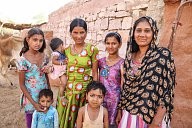
Portraits of women and children of Rajasthan. In the countryside, the women of Rajasthan wear long skirts, a small bolero and veil with bright colors. They adorn themselves with silver jewels ( earrings, nose rings, necklaces, arm and ankle bracelets). They raise the children and participate in the rural works ( cattle, farming, wood and water tasks). Most of the marriages are settled and the place of women is by and at the service of their in-laws.
Sandrine Huet / Le Pictorium
LePictorium_0146597.jpg
Pictures of Rajasthan, portraits and lifestyles
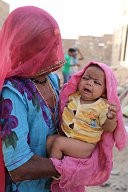
Portraits of women and children of Rajasthan. In the countryside, the women of Rajasthan wear long skirts, a small bolero and veil with bright colors. They adorn themselves with silver jewels ( earrings, nose rings, necklaces, arm and ankle bracelets). They raise the children and participate in the rural works ( cattle, farming, wood and water tasks). Most of the marriages are settled and the place of women is by and at the service of their in-laws.
Sandrine Huet / Le Pictorium
LePictorium_0146598.jpg
Pictures of Rajasthan, portraits and lifestyles
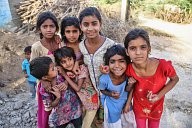
Portraits of women and children of Rajasthan. In the countryside, the women of Rajasthan wear long skirts, a small bolero and veil with bright colors. They adorn themselves with silver jewels ( earrings, nose rings, necklaces, arm and ankle bracelets). They raise the children and participate in the rural works ( cattle, farming, wood and water tasks). Most of the marriages are settled and the place of women is by and at the service of their in-laws.
Sandrine Huet / Le Pictorium
LePictorium_0146599.jpg
Pictures of Rajasthan, portraits and lifestyles

Portraits of women and children of Rajasthan. In the countryside, the women of Rajasthan wear long skirts, a small bolero and veil with bright colors. They adorn themselves with silver jewels ( earrings, nose rings, necklaces, arm and ankle bracelets). They raise the children and participate in the rural works ( cattle, farming, wood and water tasks). Most of the marriages are settled and the place of women is by and at the service of their in-laws.
Sandrine Huet / Le Pictorium
LePictorium_0146600.jpg
Pictures of Rajasthan, portraits and lifestyles
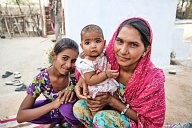
Portraits of women and children of Rajasthan. In the countryside, the women of Rajasthan wear long skirts, a small bolero and veil with bright colors. They adorn themselves with silver jewels ( earrings, nose rings, necklaces, arm and ankle bracelets). They raise the children and participate in the rural works ( cattle, farming, wood and water tasks). Most of the marriages are settled and the place of women is by and at the service of their in-laws.
Sandrine Huet / Le Pictorium
LePictorium_0146601.jpg
Pictures of Rajasthan, portraits and lifestyles
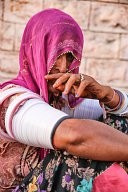
Portraits of women and children of Rajasthan. In the countryside, the women of Rajasthan wear long skirts, a small bolero and veil with bright colors. They adorn themselves with silver jewels ( earrings, nose rings, necklaces, arm and ankle bracelets). They raise the children and participate in the rural works ( cattle, farming, wood and water tasks). Most of the marriages are settled and the place of women is by and at the service of their in-laws.
Sandrine Huet / Le Pictorium
LePictorium_0146602.jpg
Pictures of Rajasthan, portraits and lifestyles
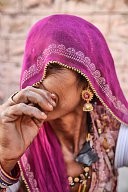
Portraits of women and children of Rajasthan. In the countryside, the women of Rajasthan wear long skirts, a small bolero and veil with bright colors. They adorn themselves with silver jewels ( earrings, nose rings, necklaces, arm and ankle bracelets). They raise the children and participate in the rural works ( cattle, farming, wood and water tasks). Most of the marriages are settled and the place of women is by and at the service of their in-laws.
Sandrine Huet / Le Pictorium
LePictorium_0146603.jpg
Pictures of Rajasthan, portraits and lifestyles
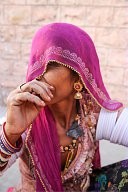
Portraits of women and children of Rajasthan. In the countryside, the women of Rajasthan wear long skirts, a small bolero and veil with bright colors. They adorn themselves with silver jewels ( earrings, nose rings, necklaces, arm and ankle bracelets). They raise the children and participate in the rural works ( cattle, farming, wood and water tasks). Most of the marriages are settled and the place of women is by and at the service of their in-laws.
Sandrine Huet / Le Pictorium
LePictorium_0146604.jpg
Pictures of Rajasthan, portraits and lifestyles
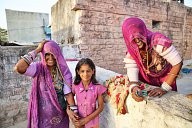
Portraits of women and children of Rajasthan. In the countryside, the women of Rajasthan wear long skirts, a small bolero and veil with bright colors. They adorn themselves with silver jewels ( earrings, nose rings, necklaces, arm and ankle bracelets). They raise the children and participate in the rural works ( cattle, farming, wood and water tasks). Most of the marriages are settled and the place of women is by and at the service of their in-laws.
Sandrine Huet / Le Pictorium
LePictorium_0146605.jpg
Pictures of Rajasthan, portraits and lifestyles

Portraits of women and children of Rajasthan. In the countryside, the women of Rajasthan wear long skirts, a small bolero and veil with bright colors. They adorn themselves with silver jewels ( earrings, nose rings, necklaces, arm and ankle bracelets). They raise the children and participate in the rural works ( cattle, farming, wood and water tasks). Most of the marriages are settled and the place of women is by and at the service of their in-laws.
Sandrine Huet / Le Pictorium
LePictorium_0146606.jpg
Pictures of Rajasthan, portraits and lifestyles
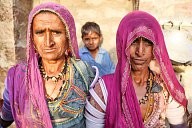
Portraits of women and children of Rajasthan. In the countryside, the women of Rajasthan wear long skirts, a small bolero and veil with bright colors. They adorn themselves with silver jewels ( earrings, nose rings, necklaces, arm and ankle bracelets). They raise the children and participate in the rural works ( cattle, farming, wood and water tasks). Most of the marriages are settled and the place of women is by and at the service of their in-laws.
Sandrine Huet / Le Pictorium
LePictorium_0146607.jpg
Pictures of Rajasthan, portraits and lifestyles

Portraits of women and children of Rajasthan. In the countryside, the women of Rajasthan wear long skirts, a small bolero and veil with bright colors. They adorn themselves with silver jewels ( earrings, nose rings, necklaces, arm and ankle bracelets). They raise the children and participate in the rural works ( cattle, farming, wood and water tasks). Most of the marriages are settled and the place of women is by and at the service of their in-laws.
Sandrine Huet / Le Pictorium
LePictorium_0146608.jpg
Pictures of Rajasthan, portraits and lifestyles
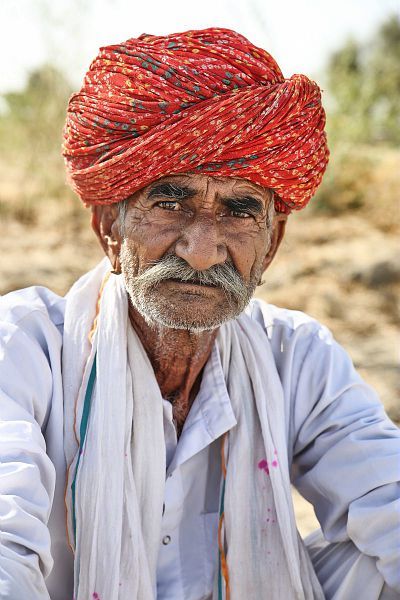
Portraits of men in Rajasthan
Sandrine Huet / Le Pictorium
LePictorium_0146609.jpg
Men of Rajasthan are very often breeders, ex nomads called Raikas.
they wear a 9 meter-long turban that is the main piece of their traditional costume. It has multi purposes and informs on the man's social status. Men in Rajasthan often have a mustache as a symbol of their virility.
they wear a 9 meter-long turban that is the main piece of their traditional costume. It has multi purposes and informs on the man's social status. Men in Rajasthan often have a mustache as a symbol of their virility.
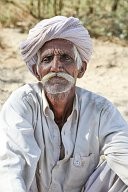
Portraits of men in Rajasthan
Sandrine Huet / Le Pictorium
LePictorium_0146610.jpg
Men of Rajasthan are very often breeders, ex nomads called Raikas.
they wear a 9 meter-long turban that is the main piece of their traditional costume. It has multi purposes and informs on the man's social status. Men in Rajasthan often have a mustache as a symbol of their virility.
they wear a 9 meter-long turban that is the main piece of their traditional costume. It has multi purposes and informs on the man's social status. Men in Rajasthan often have a mustache as a symbol of their virility.
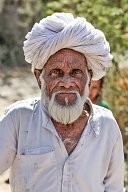
Portraits of men in Rajasthan
Sandrine Huet / Le Pictorium
LePictorium_0146611.jpg
Men of Rajasthan are very often breeders, ex nomads called Raikas.
they wear a 9 meter-long turban that is the main piece of their traditional costume. It has multi purposes and informs on the man's social status. Men in Rajasthan often have a mustache as a symbol of their virility.
they wear a 9 meter-long turban that is the main piece of their traditional costume. It has multi purposes and informs on the man's social status. Men in Rajasthan often have a mustache as a symbol of their virility.
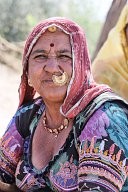
Portraits of women and children of Rajasthan. In the countryside, the women of Rajasthan wear long skirts, a small bolero and veil with bright colors. They adorn themselves with silver jewels ( earrings, nose rings, necklaces, arm and ankle bracelets). They raise the children and participate in the rural works ( cattle, farming, wood and water tasks). Most of the marriages are settled and the place of women is by and at the service of their in-laws.
Sandrine Huet / Le Pictorium
LePictorium_0146612.jpg
Pictures of Rajasthan, portraits and lifestyles
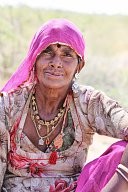
Portraits of women and children of Rajasthan. In the countryside, the women of Rajasthan wear long skirts, a small bolero and veil with bright colors. They adorn themselves with silver jewels ( earrings, nose rings, necklaces, arm and ankle bracelets). They raise the children and participate in the rural works ( cattle, farming, wood and water tasks). Most of the marriages are settled and the place of women is by and at the service of their in-laws.
Sandrine Huet / Le Pictorium
LePictorium_0146613.jpg
Pictures of Rajasthan, portraits and lifestyles
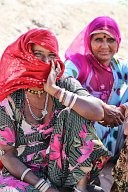
Portraits of women and children of Rajasthan. In the countryside, the women of Rajasthan wear long skirts, a small bolero and veil with bright colors. They adorn themselves with silver jewels ( earrings, nose rings, necklaces, arm and ankle bracelets). They raise the children and participate in the rural works ( cattle, farming, wood and water tasks). Most of the marriages are settled and the place of women is by and at the service of their in-laws.
Sandrine Huet / Le Pictorium
LePictorium_0146614.jpg
Pictures of Rajasthan, portraits and lifestyles
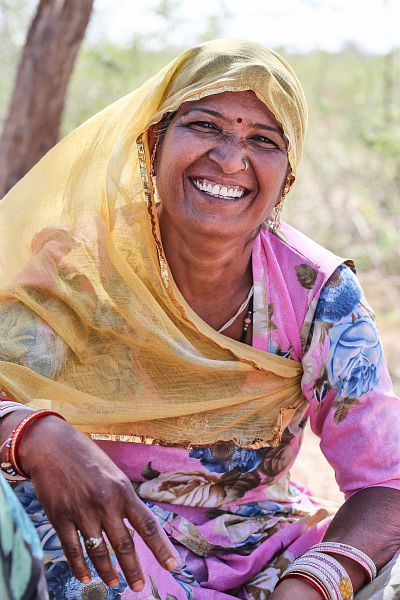
Portraits of women and children of Rajasthan. In the countryside, the women of Rajasthan wear long skirts, a small bolero and veil with bright colors. They adorn themselves with silver jewels ( earrings, nose rings, necklaces, arm and ankle bracelets). They raise the children and participate in the rural works ( cattle, farming, wood and water tasks). Most of the marriages are settled and the place of women is by and at the service of their in-laws.
Sandrine Huet / Le Pictorium
LePictorium_0146615.jpg
Pictures of Rajasthan, portraits and lifestyles
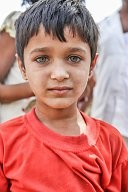
Rajasthan
Sandrine Huet / Le Pictorium
LePictorium_0146616.jpg
Pictures of Rajasthan, portraits and lifestyles
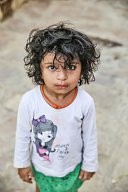
Rajasthan
Sandrine Huet / Le Pictorium
LePictorium_0146617.jpg
Pictures of Rajasthan, portraits and lifestyles
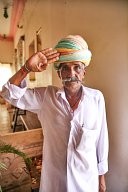
Portraits of men in Rajasthan
Sandrine Huet / Le Pictorium
LePictorium_0146618.jpg
Men of Rajasthan are very often breeders, ex nomads called Raikas.
they wear a 9 meter-long turban that is the main piece of their traditional costume. It has multi purposes and informs on the man's social status. Men in Rajasthan often have a mustache as a symbol of their virility.
they wear a 9 meter-long turban that is the main piece of their traditional costume. It has multi purposes and informs on the man's social status. Men in Rajasthan often have a mustache as a symbol of their virility.
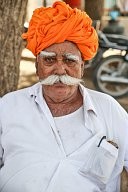
Portraits of men in Rajasthan
Sandrine Huet / Le Pictorium
LePictorium_0146619.jpg
Men of Rajasthan are very often breeders, ex nomads called Raikas.
they wear a 9 meter-long turban that is the main piece of their traditional costume. It has multi purposes and informs on the man's social status. Men in Rajasthan often have a mustache as a symbol of their virility.
they wear a 9 meter-long turban that is the main piece of their traditional costume. It has multi purposes and informs on the man's social status. Men in Rajasthan often have a mustache as a symbol of their virility.

Portraits of men in Rajasthan
Sandrine Huet / Le Pictorium
LePictorium_0146620.jpg
Men of Rajasthan are very often breeders, ex nomads called Raikas.
they wear a 9 meter-long turban that is the main piece of their traditional costume. It has multi purposes and informs on the man's social status. Men in Rajasthan often have a mustache as a symbol of their virility.
they wear a 9 meter-long turban that is the main piece of their traditional costume. It has multi purposes and informs on the man's social status. Men in Rajasthan often have a mustache as a symbol of their virility.
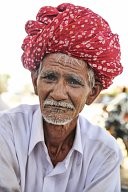
Portraits of men in Rajasthan
Sandrine Huet / Le Pictorium
LePictorium_0146621.jpg
Men of Rajasthan are very often breeders, ex nomads called Raikas.
they wear a 9 meter-long turban that is the main piece of their traditional costume. It has multi purposes and informs on the man's social status. Men in Rajasthan often have a mustache as a symbol of their virility.
they wear a 9 meter-long turban that is the main piece of their traditional costume. It has multi purposes and informs on the man's social status. Men in Rajasthan often have a mustache as a symbol of their virility.
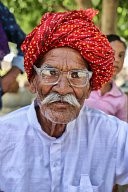
Portraits of men in Rajasthan
Sandrine Huet / Le Pictorium
LePictorium_0146622.jpg
Men of Rajasthan are very often breeders, ex nomads called Raikas.
they wear a 9 meter-long turban that is the main piece of their traditional costume. It has multi purposes and informs on the man's social status. Men in Rajasthan often have a mustache as a symbol of their virility.
they wear a 9 meter-long turban that is the main piece of their traditional costume. It has multi purposes and informs on the man's social status. Men in Rajasthan often have a mustache as a symbol of their virility.
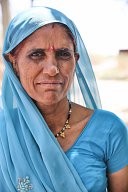
Portraits of women and children of Rajasthan. In the countryside, the women of Rajasthan wear long skirts, a small bolero and veil with bright colors. They adorn themselves with silver jewels ( earrings, nose rings, necklaces, arm and ankle bracelets). They raise the children and participate in the rural works ( cattle, farming, wood and water tasks). Most of the marriages are settled and the place of women is by and at the service of their in-laws.
Sandrine Huet / Le Pictorium
LePictorium_0146623.jpg
Pictures of Rajasthan, portraits and lifestyles
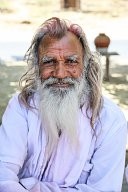
Portraits of men in Rajasthan
Sandrine Huet / Le Pictorium
LePictorium_0146624.jpg
Men of Rajasthan are very often breeders, ex nomads called Raikas.
they wear a 9 meter-long turban that is the main piece of their traditional costume. It has multi purposes and informs on the man's social status. Men in Rajasthan often have a mustache as a symbol of their virility.
they wear a 9 meter-long turban that is the main piece of their traditional costume. It has multi purposes and informs on the man's social status. Men in Rajasthan often have a mustache as a symbol of their virility.
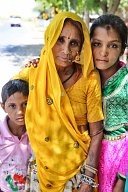
Portraits of women and children of Rajasthan. In the countryside, the women of Rajasthan wear long skirts, a small bolero and veil with bright colors. They adorn themselves with silver jewels ( earrings, nose rings, necklaces, arm and ankle bracelets). They raise the children and participate in the rural works ( cattle, farming, wood and water tasks). Most of the marriages are settled and the place of women is by and at the service of their in-laws.
Sandrine Huet / Le Pictorium
LePictorium_0146625.jpg
Pictures of Rajasthan, portraits and lifestyles
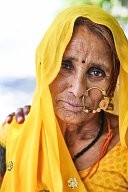
Portraits of women and children of Rajasthan. In the countryside, the women of Rajasthan wear long skirts, a small bolero and veil with bright colors. They adorn themselves with silver jewels ( earrings, nose rings, necklaces, arm and ankle bracelets). They raise the children and participate in the rural works ( cattle, farming, wood and water tasks). Most of the marriages are settled and the place of women is by and at the service of their in-laws.
Sandrine Huet / Le Pictorium
LePictorium_0146626.jpg
Pictures of Rajasthan, portraits and lifestyles
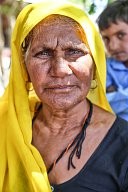
Portraits of women and children of Rajasthan. In the countryside, the women of Rajasthan wear long skirts, a small bolero and veil with bright colors. They adorn themselves with silver jewels ( earrings, nose rings, necklaces, arm and ankle bracelets). They raise the children and participate in the rural works ( cattle, farming, wood and water tasks). Most of the marriages are settled and the place of women is by and at the service of their in-laws.
Sandrine Huet / Le Pictorium
LePictorium_0146627.jpg
Pictures of Rajasthan, portraits and lifestyles
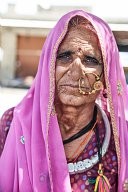
Portraits of women and children of Rajasthan. In the countryside, the women of Rajasthan wear long skirts, a small bolero and veil with bright colors. They adorn themselves with silver jewels ( earrings, nose rings, necklaces, arm and ankle bracelets). They raise the children and participate in the rural works ( cattle, farming, wood and water tasks). Most of the marriages are settled and the place of women is by and at the service of their in-laws.
Sandrine Huet / Le Pictorium
LePictorium_0146628.jpg
Pictures of Rajasthan, portraits and lifestyles
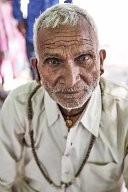
Portraits of men in Rajasthan
Sandrine Huet / Le Pictorium
LePictorium_0146629.jpg
Men of Rajasthan are very often breeders, ex nomads called Raikas.
they wear a 9 meter-long turban that is the main piece of their traditional costume. It has multi purposes and informs on the man's social status. Men in Rajasthan often have a mustache as a symbol of their virility.
they wear a 9 meter-long turban that is the main piece of their traditional costume. It has multi purposes and informs on the man's social status. Men in Rajasthan often have a mustache as a symbol of their virility.
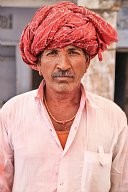
Portraits of men in Rajasthan
Sandrine Huet / Le Pictorium
LePictorium_0146630.jpg
Men of Rajasthan are very often breeders, ex nomads called Raikas.
they wear a 9 meter-long turban that is the main piece of their traditional costume. It has multi purposes and informs on the man's social status. Men in Rajasthan often have a mustache as a symbol of their virility.
they wear a 9 meter-long turban that is the main piece of their traditional costume. It has multi purposes and informs on the man's social status. Men in Rajasthan often have a mustache as a symbol of their virility.
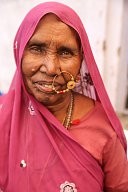
Portraits of women and children of Rajasthan. In the countryside, the women of Rajasthan wear long skirts, a small bolero and veil with bright colors. They adorn themselves with silver jewels ( earrings, nose rings, necklaces, arm and ankle bracelets). They raise the children and participate in the rural works ( cattle, farming, wood and water tasks). Most of the marriages are settled and the place of women is by and at the service of their in-laws.
Sandrine Huet / Le Pictorium
LePictorium_0146631.jpg
Pictures of Rajasthan, portraits and lifestyles
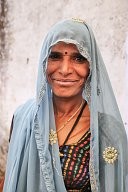
Portraits of women and children of Rajasthan. In the countryside, the women of Rajasthan wear long skirts, a small bolero and veil with bright colors. They adorn themselves with silver jewels ( earrings, nose rings, necklaces, arm and ankle bracelets). They raise the children and participate in the rural works ( cattle, farming, wood and water tasks). Most of the marriages are settled and the place of women is by and at the service of their in-laws.
Sandrine Huet / Le Pictorium
LePictorium_0146632.jpg
Pictures of Rajasthan, portraits and lifestyles
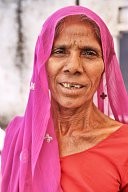
Portraits of women and children of Rajasthan. In the countryside, the women of Rajasthan wear long skirts, a small bolero and veil with bright colors. They adorn themselves with silver jewels ( earrings, nose rings, necklaces, arm and ankle bracelets). They raise the children and participate in the rural works ( cattle, farming, wood and water tasks). Most of the marriages are settled and the place of women is by and at the service of their in-laws.
Sandrine Huet / Le Pictorium
LePictorium_0146633.jpg
Pictures of Rajasthan, portraits and lifestyles
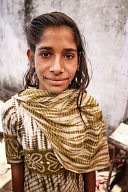
Portraits of women and children of Rajasthan. In the countryside, the women of Rajasthan wear long skirts, a small bolero and veil with bright colors. They adorn themselves with silver jewels ( earrings, nose rings, necklaces, arm and ankle bracelets). They raise the children and participate in the rural works ( cattle, farming, wood and water tasks). Most of the marriages are settled and the place of women is by and at the service of their in-laws.
Sandrine Huet / Le Pictorium
LePictorium_0146634.jpg
Pictures of Rajasthan, portraits and lifestyles
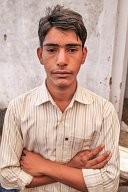
Portraits of men in Rajasthan
Sandrine Huet / Le Pictorium
LePictorium_0146635.jpg
Men of Rajasthan are very often breeders, ex nomads called Raikas.
they wear a 9 meter-long turban that is the main piece of their traditional costume. It has multi purposes and informs on the man's social status. Men in Rajasthan often have a mustache as a symbol of their virility.
they wear a 9 meter-long turban that is the main piece of their traditional costume. It has multi purposes and informs on the man's social status. Men in Rajasthan often have a mustache as a symbol of their virility.
Next page
